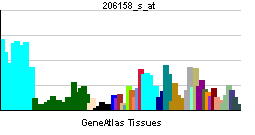CNBP
| CCHC-type zinc finger, nucleic acid binding protein | |||||||||||
|---|---|---|---|---|---|---|---|---|---|---|---|
| Identifiers | |||||||||||
| Symbols | CNBP ; CNBP1; DM2; PROMM; RNF163; ZCCHC22; ZNF9 | ||||||||||
| External IDs | Template:OMIM5 Template:MGI HomoloGene: 2567 | ||||||||||
| |||||||||||
| RNA expression pattern | |||||||||||
 | |||||||||||
| More reference expression data | |||||||||||
| Orthologs | |||||||||||
| Template:GNF Ortholog box | |||||||||||
| Species | Human | Mouse | |||||||||
| Entrez | n/a | n/a | |||||||||
| Ensembl | n/a | n/a | |||||||||
| UniProt | n/a | n/a | |||||||||
| RefSeq (mRNA) | n/a | n/a | |||||||||
| RefSeq (protein) | n/a | n/a | |||||||||
| Location (UCSC) | n/a | n/a | |||||||||
| PubMed search | n/a | n/a | |||||||||
CCHC-type zinc finger, nucleic acid binding protein, also known as CNBP, is a human gene.[1]
The ZNF9 protein contains 7 zinc finger domains and is believed to function as an RNA-binding protein. A CCTG expansion in intron 1 of the ZNF9 gene results in myotonic dystrophy type 2 (MIM 602668).[supplied by OMIM][1]
References
Further reading
- Lusis AJ, Rajavashisth TB, Klisak I; et al. (1991). "Mapping of the gene for CNBP, a finger protein, to human chromosome 3q13.3-q24". Genomics. 8 (2): 411–4. PMID 2249857.
- Rajavashisth TB, Taylor AK, Andalibi A; et al. (1989). "Identification of a zinc finger protein that binds to the sterol regulatory element". Science. 245 (4918): 640–3. PMID 2562787.
- Flink IL, Morkin E (1995). "Organization of the gene encoding cellular nucleic acid-binding protein". Gene. 163 (2): 279–82. PMID 7590281.
- Warden CH, Krisans SK, Purcell-Huynh D; et al. (1995). "Mouse cellular nucleic acid binding proteins: a highly conserved family identified by genetic mapping and sequencing". Genomics. 24 (1): 14–9. doi:10.1006/geno.1994.1576. PMID 7896269.
- Ricker K, Grimm T, Koch MC; et al. (1999). "Linkage of proximal myotonic myopathy to chromosome 3q". Neurology. 52 (1): 170–1. PMID 9921867.
- Liquori CL, Ricker K, Moseley ML; et al. (2001). "Myotonic dystrophy type 2 caused by a CCTG expansion in intron 1 of ZNF9". Science. 293 (5531): 864–7. doi:10.1126/science.1062125. PMID 11486088.
- Strausberg RL, Feingold EA, Grouse LH; et al. (2003). "Generation and initial analysis of more than 15,000 full-length human and mouse cDNA sequences". Proc. Natl. Acad. Sci. U.S.A. 99 (26): 16899–903. doi:10.1073/pnas.242603899. PMID 12477932.
- McGrath CF, Buckman JS, Gagliardi TD; et al. (2003). "Human cellular nucleic acid-binding protein Zn2+ fingers support replication of human immunodeficiency virus type 1 when they are substituted in the nucleocapsid protein". J. Virol. 77 (15): 8524–31. PMID 12857921.
- Ota T, Suzuki Y, Nishikawa T; et al. (2004). "Complete sequencing and characterization of 21,243 full-length human cDNAs". Nat. Genet. 36 (1): 40–5. doi:10.1038/ng1285. PMID 14702039.
- Gerhard DS, Wagner L, Feingold EA; et al. (2004). "The status, quality, and expansion of the NIH full-length cDNA project: the Mammalian Gene Collection (MGC)". Genome Res. 14 (10B): 2121–7. doi:10.1101/gr.2596504. PMID 15489334.
- Vallo L, Bonifazi E, Borgiani P; et al. (2005). "Characterization of a single nucleotide polymorphism in the ZNF9 gene and analysis of association with myotonic dystrophy type II (DM2) in the Italian population". Mol. Cell. Probes. 19 (1): 71–4. doi:10.1016/j.mcp.2004.09.003. PMID 15652222.
- Botta A, Caldarola S, Vallo L; et al. (2006). "Effect of the [CCTG]n repeat expansion on ZNF9 expression in myotonic dystrophy type II (DM2)". Biochim. Biophys. Acta. 1762 (3): 329–34. doi:10.1016/j.bbadis.2005.11.004. PMID 16376058.
- Margolis JM, Schoser BG, Moseley ML; et al. (2006). "DM2 intronic expansions: evidence for CCUG accumulation without flanking sequence or effects on ZNF9 mRNA processing or protein expression". Hum. Mol. Genet. 15 (11): 1808–15. doi:10.1093/hmg/ddl103. PMID 16624843.
- Toth C, Dunham C, Suchowersky O; et al. (2007). "Unusual clinical, laboratory, and muscle histopathological findings in a family with myotonic dystrophy type 2". Muscle Nerve. 35 (2): 259–64. doi:10.1002/mus.20685. PMID 17068784.
- Gerbasi VR, Link AJ (2007). "The myotonic dystrophy type 2 protein ZNF9 is part of an ITAF complex that promotes cap-independent translation". Mol. Cell Proteomics. 6 (6): 1049–58. doi:10.1074/mcp.M600384-MCP200. PMID 17327219.
- Ewing RM, Chu P, Elisma F; et al. (2007). "Large-scale mapping of human protein-protein interactions by mass spectrometry". Mol. Syst. Biol. 3: 89. doi:10.1038/msb4100134. PMID 17353931.
External links
- ZNF9+protein,+human at the US National Library of Medicine Medical Subject Headings (MeSH)
This article incorporates text from the United States National Library of Medicine, which is in the public domain.
| This protein-related article is a stub. You can help Wikipedia by expanding it. |